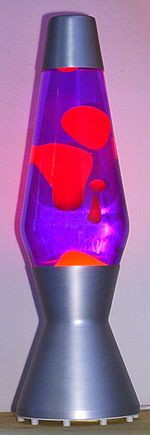Lava lamp

A lava lamp is a novelty item typically used for decoration rather than illumination. The gentle flow of randomly-shaped blobs of wax suggests the flowing of lava. The lamps are available with a wide variety of container styles and colours of wax and liquid.
How it works
The lamp consists of an illuminating bulb which heats up the lamp's contents, a glass bottle containing a water and translucent mix of wax and carbon tetrachloride (although other combinations may be used), and a metallic wire coil. The glass bottle sits on top of the bulb. The metallic wire coil is hidden in the base of the lamp, on which the glass bottle is sitting.
The wax is slightly more dense than the water at room temperature, and slightly less dense than the water under marginally warmer conditions. This happens because the wax expands more than the oil when both are heated.
When the lava lamp is turned on, the light bulb heats the bottom of the glass bottle which in turn heats the contents of the glass bottle in this vicinity.
Wax at the bottom heats until it melts, and eventually becomes less dense than the liquid above it. At this time, a portion of the wax rises towards the top of the container. Near the top, away from the heat source, the wax cools, contracts, and as its density increases it begins to fall through the liquid towards the bottom of the container again. This is a macroscopic, visible form of convection heat transfer, although it also occurs on a molecular scale within the liquid itself. The difference in temperature between the top and bottom of the globe is only a few degrees.
One mass of wax may rise as another falls. The metal coil at the bottom helps to overcome the surface tension of the individual wax droplets, causing the descending blobs to coalesce into a single molten wax mass at the bottom of the container. The cycle of rising and falling wax droplets continues so long as the bottom of the container remains warm and the top of the container remains cool. Operating temperatures of lava lamps vary, but are normally around 60 °C (140 °F). If too low or too high a wattage bulb is used in the base, the "lava" ceases to circulate, either remaining quiescent at the bottom (too cold) or all rising to the top (too hot).
Chaotic behavior makes the movement of the wax unpredictable. The Lavarand system used this unpredictability as the basis of a hardware random number generator.
History
An Englishman, Edward Craven Walker, invented the original and best-known lava lamp in the 1960s. His U.S. patent 3,570,156 for "Display Device" was filed in 1965 and issued in 1968. [1] He named it the "Astrolight" or "Astro Lamp" and presented it at a Hamburg trade show in 1965, where the entrepreneur Adolph Wertheimer noticed it. Wertheimer and his business partner Hy Spector bought the American rights to the product and began to produce it as the "Lava Lite" via a corporation called Haggerty Enterprises and trading under the name LavaWorld International.
The lava lamp became an icon of the 1960s, where the constantly changing, brightly-coloured display has been compared to the psychedelic hallucinations of certain popular recreational drugs. In the 1990s Mr. Walker sold his rights to Cressida Granger whose company Mathmos continues to make lava lamps and other related products.
Trivia
Lava lamps were also featured in an episode of the TV show MythBusters, in which it was demonstrated that heating a lava lamp on a stove could cause the lamp to explode, and injuries sustained from such an explosion could be fatal.
See also
External links
- Oozing Goo, The Lava Lamp Syndicate Extensive lava lamp fansite which includes discussion forums, history, formulas, and vintage lamp gallery.
- Lava Lamp Patent referenced above.
- Video of a lava lamp in motion.
- Lava Lamp Care How to take care of and fix common problems with a lava lamp.
- How Do Lava Lamps Work? (from The Straight Dope)
- How Liquid Motion Lamps Work (from howstuffworks.com)
- Darwin Award: Exploding Lava Lamp Kills Man
